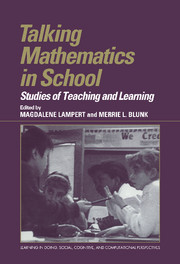Book contents
- Frontmatter
- Contents
- Series Foreword
- Acknowledgments
- List of Contributors
- 1 Introduction
- Part I Doing and Learning Mathematical Talk
- 2 Language Socialization in the Mathematics Classroom: Discourse Practices and Mathematical Thinking
- 3 The Role of Imagery and Discourse in Supporting Students' Mathematical Development
- 4 Building a Context for Mathematical Discussion
- 5 Disciplined Perception: Learning to See in Technoscience
- Part II Teaching Mathematical Talk
- Afterword
- Author Index
- Subject Index
2 - Language Socialization in the Mathematics Classroom: Discourse Practices and Mathematical Thinking
Published online by Cambridge University Press: 04 August 2010
- Frontmatter
- Contents
- Series Foreword
- Acknowledgments
- List of Contributors
- 1 Introduction
- Part I Doing and Learning Mathematical Talk
- 2 Language Socialization in the Mathematics Classroom: Discourse Practices and Mathematical Thinking
- 3 The Role of Imagery and Discourse in Supporting Students' Mathematical Development
- 4 Building a Context for Mathematical Discussion
- 5 Disciplined Perception: Learning to See in Technoscience
- Part II Teaching Mathematical Talk
- Afterword
- Author Index
- Subject Index
Summary
Implicit in the current consensus documents about mathematics education reform is an idea concerning the connection between communication about mathematics and actual mathematics learning. That idea – that somehow communication facilitates mathematics learning – remains nebulous: Rarely is there discussion of why “communication” should enhance “learning” or even of what we might understand communication to be. Some researchers seem to be concerned with communication in the sense of clear explanation, while others seem to be concerned with complex social practices embodied in discourse, practices that indicate membership in a discipline. Before providing a sketch of the contents of this chapter, I will consider two perspectives on the topic of mathematics and communication, as a way of locating the proposals to be developed below.
The Process–Product Tradition
Within the process–product tradition, “communication” can be understood most simply as “talk about (mathematics),” and “learning” can be interpreted in terms of individuals' performance on assessments of their understanding. The idea introduced above then emerges in an obvious and seemingly testable form: More talk about mathematics enables more learning about mathematics. Most of the studies in the process–product tradition suggest that such a relationship exists. They find reliable effects for certain types of instruction, coded in terms of verbal interaction or discourse. For example, Webb (1991) carried out a study in which she examined the results of seventeen previous studies that explored peer interaction and achievement in small groups.
- Type
- Chapter
- Information
- Talking Mathematics in SchoolStudies of Teaching and Learning, pp. 17 - 55Publisher: Cambridge University PressPrint publication year: 1998
- 29
- Cited by



